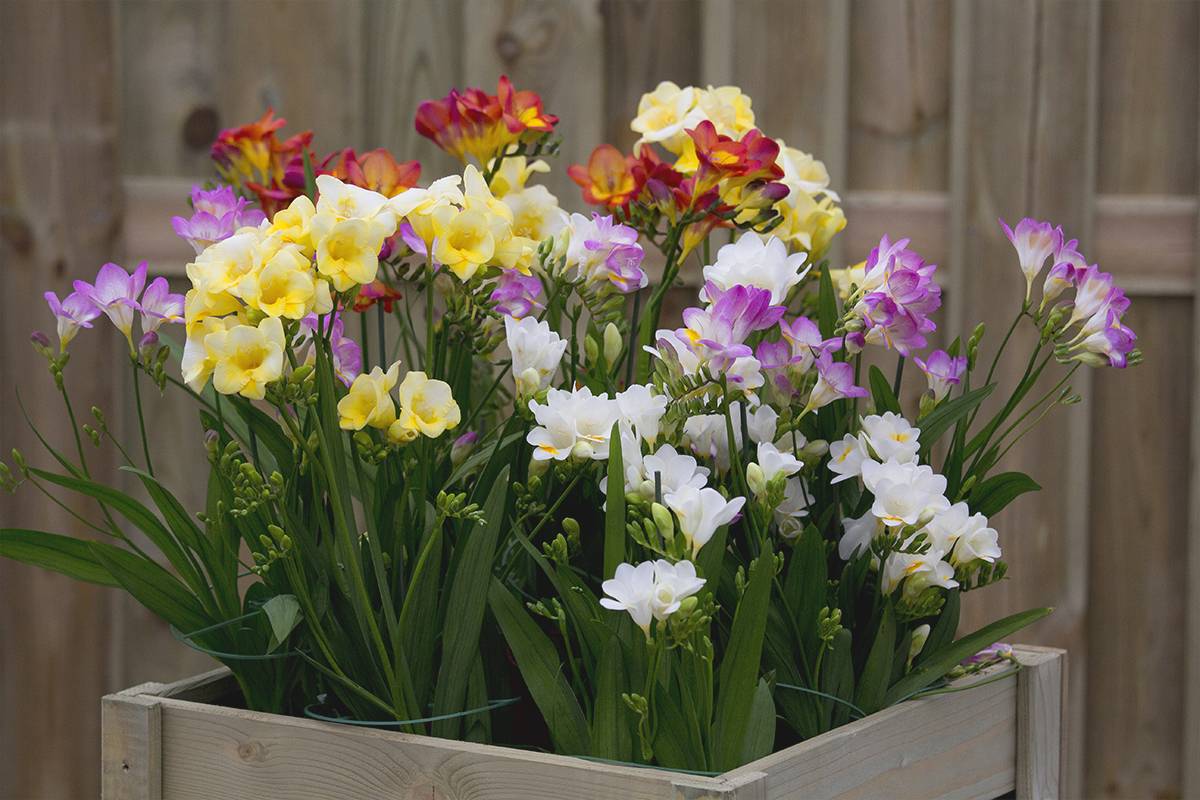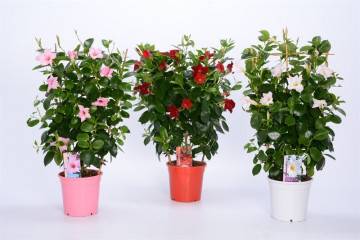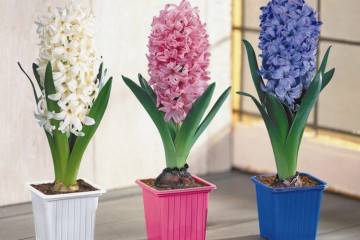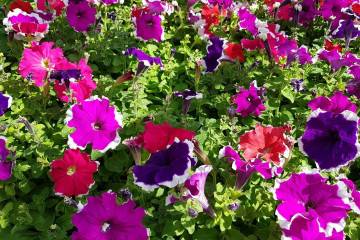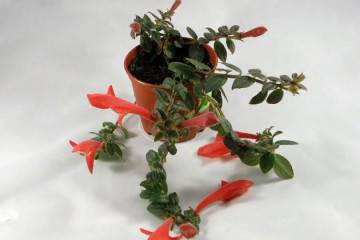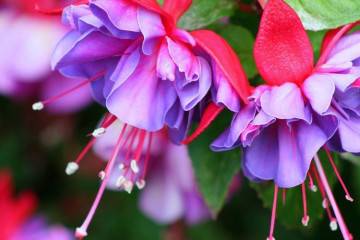Freesia cultivation and care at home and in the garden
Content:
Freesia is a bulbous plant with a scent of lily of the valley. The scent of double freesia flowers soothes and relieves tension and stress. There are many types of this beautiful flower. You can grow it on the balcony, dacha and in a greenhouse.
Popular varieties
Each type of freesia is good in its own way. The most popular are 3 varieties. If it is difficult to decide, you can buy a mix of different types in a set.
Armstrong (Freesia armstrongii)
This is the most famous plant variety. The flowers are distinguished by a bright color and a pronounced smell. White bell buds have orange spots at the base, perianths are purple-pink. There are varieties with red, purple or blue petals. Maximum height 65 cm, bud diameter 5 cm.
Alba (Freesia refracta var.alba)
Freesia Alba has a spikelet that is split during flowering. The inflorescence consists of 10 snow-white flowers. The petals are corrugated with a smooth transition to yellow at the base.
Unlike other varieties, Alba does not have a pronounced odor.
Maximum height 35 cm, bud diameter 7 cm.
Fragrant (Freesia refracta odorata)
It is easy to guess from the name that the flower has a rich aroma. Fragrant has the smell of lily of the valley. The inflorescence consists of 6-8 bright yellow buds with orange specks at the bottom. The flowers are in the form of a narrowed tube. Bushes of medium density with an even thin stem.
Breeding methods for garden and indoor flowers
Freesia can be propagated in two ways: by means of daughter bulbs and by seeds. Reproduction using seeds is considered a longer and more difficult process.
Propagation by corms
During the growing season, the bulb of an adult flower is completely renewed. After the petals have dried, they must be cut off so that the plant spends more energy on the formation of a new daughter bulb. After the last flower withers, you need to wait a week, dig up the plant and cut off the tops. Daughter corms need to be separated and planted in another place.
Seed propagation
Seed propagation is unpopular and difficult. Sowing is done in March. It is necessary to soak the seeds for a day and prepare a mixture of peat, sand and humus. The seeds should be dipped in a pot with the mixture and covered with earth on top. The favorable temperature for seed germination is 25 ° C.
In May, seedlings need to be planted at a distance of 5 cm from each other. When the temperature drops to 10 ° C, the plants must be moved to a warm room, remembering to irrigate and feed abundantly. They will begin to bloom in February, and as the buds dry up, you can prepare the corms for planting in another way.
Freesia: growing and care in the open field
Freesia is not divided into indoor and garden views. They are one and the same flower and require different conditions for growth.
When and how to plant plants
Planting tubers is preferable in April in partial shade. The plant is light-requiring, it needs dim lighting for 12 hours a day. To grow a healthy flower, you need a temperature of 15 ° C, and for flowering - 25 ° C.
Before planting, the corms must be cleaned and washed in a manganese solution for 30 minutes.
Important! Spoiled and spotted are not suitable for planting.
How to care during growth and flowering
When planting in fertile soil, it is not worth feeding too much. After seedling formation, ammonium nitrate is required (20 g per 10 l of water). Weeding and abundant irrigation are required for the plant. When flowering, it is necessary to create a support for the thin stem. In extreme heat, you need to spray the leaves from a spray bottle, but strictly in the evening or in the morning, when the sun is not yet as hot as in the daytime.
For your information! If the flower is affected by pests, then it is better to remove it immediately.
How to prepare a plant for winter
The bulbs can be kept in the ground until early October; in Siberia and the Urals, the flower is unlikely to withstand the winter. In the southern regions, you can leave the bulb for the winter, but you need to cover the ground with straw and fallen leaves with a layer of up to 20 cm.
Storing the bulbs
The best way to store the bulbs until the next planting is to dig them up, peel them off, leave them in a weak manganese solution for an hour and dry them. The storage temperature of such bulbs should be 20–25 ° C with a humidity of 70%.
It is imperative to separate the daughter corms from the mother. The maternal will bloom next season, and the daughter ones only a year later.
Freesia: growing and care at home
For planting, it is required to prepare the corms: peel them off and stand for one hour in a fungicidal solution to avoid the appearance of fungus.
There are 3 seasons for planting freesia:
- normal - August-September;
- early - May-August;
- late - November-February.
After planting, it is important to provide the culture with proper care.
Lighting
For the normal flowering period of the plant, direct sunlight is strictly prohibited. The early period is ideal for growing freesia at home on the balcony. It is required to place the flower on the shady side away from strong sun.
With late flowering, you do not need to worry about the temperature regime, you can put the plant on the sunny side, but cover it from direct rays of the sun.
Humidity
For a normal period, it is necessary to regularly sprinkle freesia with water, or it is possible to humidify the room with vessels with water. It is necessary to maintain a humidity of 70%. For early and late, you need to maintain it up to 60%.
Temperature
The ideal temperature for growth is 10-15 ° C. It is difficult to maintain this temperature in summer due to the warm climate. Also, sudden changes in spring or autumn are dangerous for freesia, we are talking about an increase to 30 ° C and a decrease to 0 ° C. In the later period, it is better to bring the flower into the room at night, not forgetting to spray it with water.
Features of watering and feeding
Freesia shrub responds negatively to overflow and underfilling. It is best to moisten the soil as it dries by pouring water into the bottom of the tray. Top dressing is desirable once a fortnight with an ordinary mineral complex.
Freesia diseases
There are two common diseases affecting freesia: fusarium and scab.
Fusarium causes stunted roots, thinning and curvature of leaves. Bulbs affected by Fusarium will rot during storage. Burgundy brown spots appear on them. The last stage of the plant disease is characterized by yellowing and complete drying of the leaves. Infected plants must be removed along with the soil.
To prevent the appearance of the disease, it is necessary to pre-disinfect the bulbs before planting.
The scab causes yellowish-brown, dark brown spots on the bulbs and yellowing and wilting of the leaves. On the lower part of the freesia, burgundy-brown spots may form, which turn into long stripes in high humidity. This can lead to rotting of the base of the stem and leaves. No remedies have yet been found against this bacterium.Therefore, to exclude the possibility of infection, it is recommended to use healthy planting material.
Freesia is a graceful but slightly moody flower. With proper care, it will decorate a garden or balcony for a long time. A freesia bouquet or a flower in a pot will be the perfect gift for any occasion.



